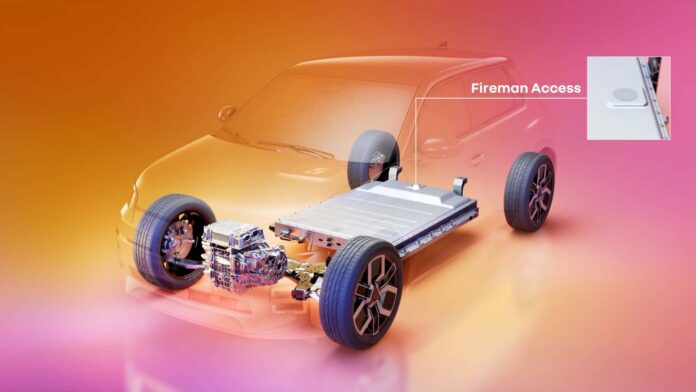
- Renault’s new solution to extinguish electric vehicle fires can help first responders take out flames faster and more efficiently.
- EV fires are statistically rarer than ICE vehicles, but in the rare cases when EV batteries catch fires, it’s difficult to get them under control.
- The French automaker has made its EV fire safety tech freely available to encourage broader adoption improve overall safety.
A growing number of automakers and battery companies are racing to solve the risk of fires in electric vehicles. Now Renault has introduced its own fix called the “Fireman Access” system, designed to douse flames more effectively and quickly.
The French carmaker’s innovation can apparently help first responders extinguish fires in roughly the same time as a combustion engine vehicle. The tech relies on an adhesive disc inside the high-voltage battery pack, positioned over an opening. If the battery catches fire, water pressure from an external hose dislodges the disc, flooding the pack and cooling all cells at once.
It claims this is an effective way of stopping thermal runaway, a phenomenon where battery cells burn uncontrollably for hours. The system is already installed on new fully electric and plug-in hybrid vehicles sold worldwide by Renault, Dacia and its quadricycle sub-brand Mobilize. Now the tech is also open to other automakers as part of the brand’s free licensing policy.
Renault claims the Fireman Access system takes only a few minutes to extinguish flames and reduces water usage tenfold. Studies have shown that EV fires are statistically rarer compared to internal-combustion car fires. But in the rare cases when batteries do ignite, the fires are notoriously difficult to extinguish and that process can often take hours.
There are also different types of fire suppression solutions out there. Last year, battery giant LG Chem said it had developed a safety layer thinner than the size of a human hair which can prevent thermal runaway. Battery scientists in South Korea have also created a new lithium metal battery that uses a solid polymer electrolyte with a layer that prevent fires entirely.
All new EVs come with comprehensive and sophisticated cooling and thermal management systems designed to keep things in check. But improving fire prevention and suppression tech remains crucial, not just to make EVs safer, but also to boost consumer confidence in what’s still a relatively new technology.
Have a tip? Contact the author: suvrat.kothari@insideevs.com


